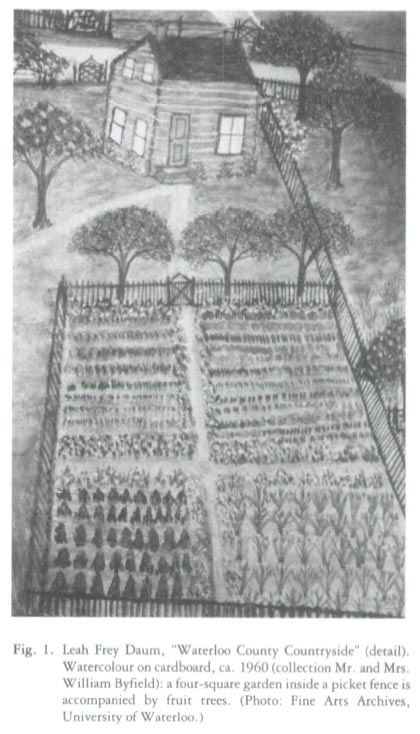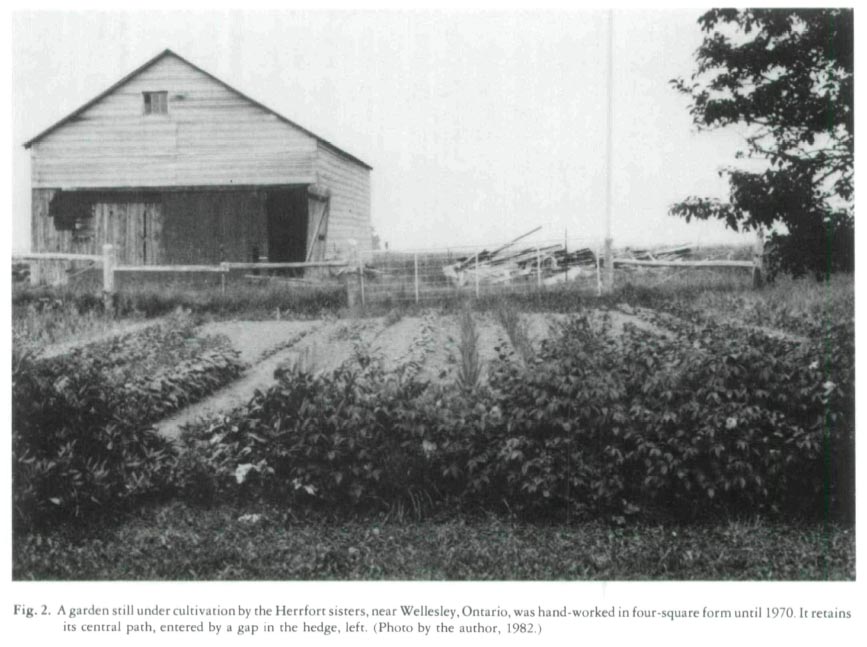Research Reports / Rapports de recherche
Waterloo Region Gardens in the Germanic Tradition
1 Waterloo Region in southern Ontario contains a variety of ethnic groups which may be designated "Germanic." Descendants of nineteenth-century settlers whose places of ancestry included Switzerland, Alsace, and parts of what are now West and East Germany, whose religious denominations included Mennonite, Amish, Lutheran, and Roman Catholic, form parts of this category.
2 The making of gardens for personal and communal use, and for ornamental and symbolic reasons, is deeply fixed in Germanic culture, and commentators from the eighteenth and nineteenth centuries have remarked upon the "German settler's garden" as a characteristic and distinctive feature of their North American settlements. The gardens of people of Germanic background, in both rural and urban settings, are a notable feature of Waterloo Region today.
3 The central paradigm of the Germanic garden is the Paradiesgartlein, an enclosed space or hortus condusus. Perhaps the fundamental pattern for this garden is formed by two crossing paths which separate four hand-worked raised or bordered beds, the "Four-Square Garden." This composition symbolizes Eden watered by the four rivers of Paradise, and the Islamic gardens which introduced this form to Europe were divided by four actual watercourses pouring from a central fountain (fig. 1). This extremely old symbolic complex has remained constant in Germanic thought. The spiritual dimension of the garden was reiterated in seventeenth- and eighteenth-century German pietistic literature, and hymns and prayers from this source still form part of Waterloo Region religious life.
4 Historically, continental German garden art can be characterized by three traits. First is the strong tendency to use rectangular shapes, to create firmly defined walled spaces, precisely subdivided. This is the perpetuation of the mediaeval idea of a garden as an enclosed space where everything is in order. Second is an interest in the scientific aspects of gardening, a tendency to develop new plants, to concentrate on medicinal and exotic forms, to publish scientific treatises on these subjects, and to illustrate them not from fancy but from life. Third, and perhaps complementary, is the vision of the garden as a religious, symbolic, and moral expression.
5 By the fourteenth century the making of fine gardens in Germany had expanded from the nobility to the burgess class, and their style had begun to be influenced by Italian models. The fifteenth and sixteenth centuries saw the publication of the great German herbals. Gardening in southern Germany was brought to a tragic halt in 1618 with the onset of the Thirty Years' War. During the recovery from this era of devastation, other influences entered: in the late seventeenth century, Baroque gardens were made after the French model, and in the eighteenth century, landscape gardens were made in the English style.
6 But settlers coming to North America from southwestern Germany in the eighteenth century brought what were essentially mediaeval traditions and adapted these to new conditions. While their barn forms and land-use patterns underwent modification and expansion, the garden proved to be a more conservative element, remaining close to the house, retaining its geometric form, its fence and four-square structure, and containing vegetables, flowers, berries, and fruit trees in a single or closely related space.
7 Mennonite settlers moving to Upper Canada from Pennsylvania in the early nineteenth century brought these garden practices with them. Amish settlers from Alsace followed their example. Later Germanic settlers of Lutheran and Roman Catholic background brought elements of the same complex, though in more varied form. The introduction of rototilling in the early twentieth century brought a gradual end to hand-worked four-square gardens but two very late survivals of this form have been studied.
8 The garden of Mrs. Clayton Toman had been converted to longitudinal form but in 1921 she recreated the foursquare shape and worked it by hand for the next fifty-seven years. Bordered on the south by a grape arbour and on the north by rhubarb and fruit trees, it contained a variety of bulbs and perennials. In 1981 it was reconverted to rototilling by her son. Although this garden has been called "the last four-square garden in Waterloo County," there is a second candidate for the status, the garden of Esther, Mary, Lydia, and Sarah Herrfort, near Wellesley, Ontario, which continued to be hand-worked without interruption until circa 1970 (fig. 2). It retains its square shape and the entrance to one of its paths demarcated by an opening in a peony plantation along the southern border. At this entrance is an "Adam and Eve plant" (as identified by the Herrfort sisters), in this case Aconit urn (Monks-hood).
9 Twentieth-century rural gardens are inclined to be large, located next to the farmhouse and close to the road. Typical is Mrs. Minerva Martin's garden, which she took over in 1939 and worked until 1977. Its large rectangular area was planted with rows of fruit trees and a rich assembly of flowers, vegetables, and berry bushes which were much admired in the neighbourhood. When the house was sold in 1979, this garden was bulldozed to create a larger lane but Mrs. Martin planted a new longitudinal garden across the back yard of her new home in nearby Elmira. A similar rural garden still under cultivation near Waterloo is the work of Amsey and Mabel Martin. The earlier garden and orchard areas were combined to produce a very large rectangular garden divided by one path, containing flowers, vegetables, and vines in rotation.
 Display large image of Figure 1
Display large image of Figure 1 Display large image of Figure 2
Display large image of Figure 210 The local villages contain numerous gardens, some of which are also very extensive. In Conestogo, behind her home and small commercial bakery, Mrs. Alvin Sittler maintains a narrow longitudinal garden nearly half a block long. In addition to the usual rows of vegetables and arbours, it contains one square hand-worked bed devoted exclusively to flowers. St. Jacobs contains two large gardens beside its main road, both produced by the sons of a retired market gardener. Aden and Alice Martin's garden is well known for its vivid flowers and is fertilized organically. On the original family property, Henry and Mary Martin maintain a large house-related garden of flowers and vegetables as well as a "field garden" for commercial produce.
11 The City of Waterloo has numerous gardens planted in side or back yards. One of the most notable was planted by Alvin and Lydia Duench in 1940 (fig. 3). It occupies the entire rear portion of their corner lot and contains flowers, vegetables, berries, herbs, and turf and earthen paths. Mrs. Duench prepares herbal remedies, teas, and seasoning with her own produce.
12 In this and the above-mentioned gardens, most of the ornament is supplied by the display of flowers, typically planted close to the house for family viewing. In addition there are bird-houses (to attract birds) and whirligigs (to repel them). Sometimes the ornamental additions become dominant, and a form of personal expression develops into the creation of full-scale "yard art" environments. In the 1970s Daniel Snyder began to decorate his Waterloo front yard with a bird-house, bird-bath, and windmill. He went on to add a large population of wooden animals of his own manufacture, including rabbits, foxes, horses, chickens, and birds.
 Display large image of Figure 3
Display large image of Figure 313 In contrast to this public display is the environment created in Waterloo by Karl Hirzer in the last two decades. The elaborate assembly includes a large windmill, an elegant castle and church, a complex stone fountain, and a neat longitudinal garden, all placed behind the house and enclosed within hedges, a true hortus conclusus, a little image of Paradise in the urbanized Regional Municipality of Waterloo.